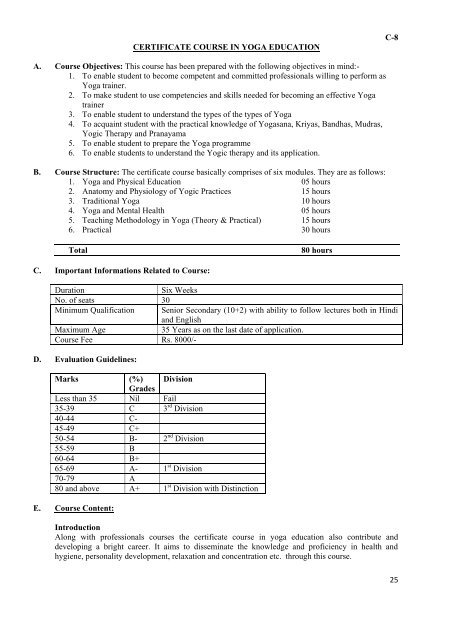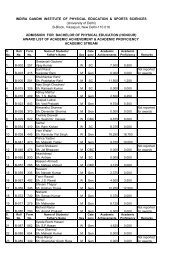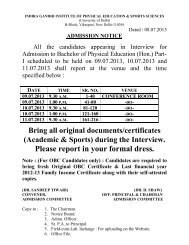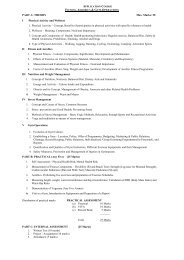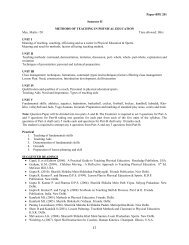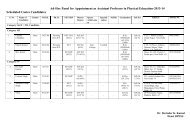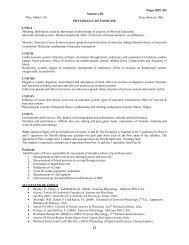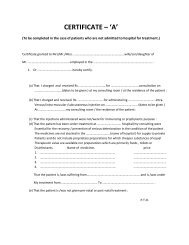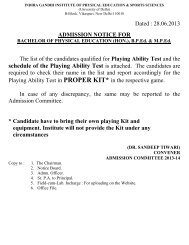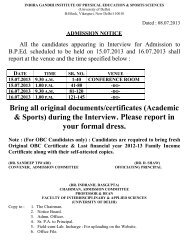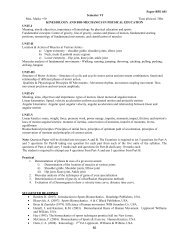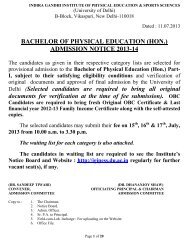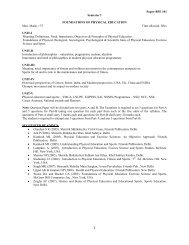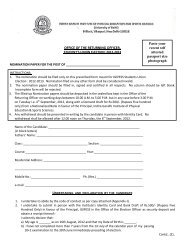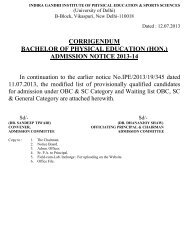25 C-8 CERTIFICATE COURSE IN YOGA EDUCATION A. Course ...
25 C-8 CERTIFICATE COURSE IN YOGA EDUCATION A. Course ...
25 C-8 CERTIFICATE COURSE IN YOGA EDUCATION A. Course ...
Create successful ePaper yourself
Turn your PDF publications into a flip-book with our unique Google optimized e-Paper software.
<strong>CERTIFICATE</strong> <strong>COURSE</strong> <strong>IN</strong> <strong>YOGA</strong> <strong>EDUCATION</strong><br />
C-8<br />
A. <strong>Course</strong> Objectives: This course has been prepared with the following objectives in mind:-<br />
1. To enable student to become competent and committed professionals willing to perform as<br />
Yoga trainer.<br />
2. To make student to use competencies and skills needed for becoming an effective Yoga<br />
trainer<br />
3. To enable student to understand the types of the types of Yoga<br />
4. To acquaint student with the practical knowledge of Yogasana, Kriyas, Bandhas, Mudras,<br />
Yogic Therapy and Pranayama<br />
5. To enable student to prepare the Yoga programme<br />
6. To enable students to understand the Yogic therapy and its application.<br />
B. <strong>Course</strong> Structure: The certificate course basically comprises of six modules. They are as follows:<br />
1. Yoga and Physical Education 05 hours<br />
2. Anatomy and Physiology of Yogic Practices 15 hours<br />
3. Traditional Yoga 10 hours<br />
4. Yoga and Mental Health 05 hours<br />
5. Teaching Methodology in Yoga (Theory & Practical) 15 hours<br />
6. Practical 30 hours<br />
Total<br />
80 hours<br />
C. Important Informations Related to <strong>Course</strong>:<br />
Duration<br />
Six Weeks<br />
No. of seats 30<br />
Minimum Qualification Senior Secondary (10+2) with ability to follow lectures both in Hindi<br />
and English<br />
Maximum Age<br />
35 Years as on the last date of application.<br />
<strong>Course</strong> Fee Rs. 8000/-<br />
D. Evaluation Guidelines:<br />
Marks (%) Division<br />
Grades<br />
Less than 35 Nil Fail<br />
35-39 C 3 rd Division<br />
40-44 C-<br />
45-49 C+<br />
50-54 B- 2 nd Division<br />
55-59 B<br />
60-64 B+<br />
65-69 A- 1 st Division<br />
70-79 A<br />
80 and above A+ 1 st Division with Distinction<br />
E. <strong>Course</strong> Content:<br />
Introduction<br />
Along with professionals courses the certificate course in yoga education also contribute and<br />
developing a bright career. It aims to disseminate the knowledge and proficiency in health and<br />
hygiene, personality development, relaxation and concentration etc. through this course.<br />
<strong>25</strong>
(i)<br />
Theory (50 Hrs.)<br />
Unit-I: Yoga and Physical Education: (5 hrs)<br />
Concepts of Yoga and Physical Education; Aims and Objectives of Yoga and Physical<br />
Education; Comparison in physical exercise and Yogic Practices; Problems of integration of<br />
personality tackled in Yoga; Application of Yoga in Physical Education; Utility of Yoga<br />
techniques in Physical Education<br />
Unit-II: Anatomy and Physiology of Yogic Practices: (15 hrs)<br />
Introduction of human body and systems in brief with special reference to stress on<br />
respiratory, digestive, muscular and nervous system; Postural Physiology with reference to<br />
Aasanas; Asana-Definition and classification. Similarities and dissimilarities, between Asana<br />
and exercise; Pranayam- Definition and classification. Difference between Pranayam and<br />
deep breathing importance of Rechka, Kumbhaka, Purraka; Introduction to Kriyas, Mudras<br />
and Bandhas in brief.<br />
Unit-III: Traditional Yoga: (10 hrs)<br />
Introduction, definition of yoga according to Patanjali, Geeta, Hath Pradipika, Gherand Samhita<br />
etc.; Yoga sutra as given in Astang Yoga of Charandas: Sanyam, Yama, Niyama, Asana, Vayu,<br />
Nadi, Pranayama and types of Kumbhakas; Pratyahara, Dharana, Dhyana, Samadhi, Satkarma<br />
Mudra and Bandh<br />
Unit-IV: Yoga and Mental Health: (5 hrs)<br />
Health, Mental Health, Hygiene, Mental hygiene: Yogic and Medical perspectives; Concept<br />
of normality: Psychological and yogic approaches; Emotional Disorders: Causes, Effects and<br />
Remedies in Patanjali Yogic approaches; Prayer-its significance in yogic practices; Anger<br />
stress management through yoga; Asthama, B.P., Diabetes, Obesities and Backache<br />
management through yoga.<br />
Unit-V: Teaching Methodology in Yoga: (5hrs theory +10hrs Practical)<br />
Introduction: Need of practice of teaching and its use in yogic practices; Involving scientific<br />
principles in teaching of yoga practice; Presentation technique: its meaning; Presentation of<br />
specific practices: Asanas, Pranayama etc.; Teaching Aids: Its meaning and need; Class<br />
Management: Its meaning and need; Lesson Plan: Its meaning and need; Preparation of<br />
Lesson Plan in yogic practices; Time allotment in different yogic lesson plans; Lesson<br />
presentation.<br />
(ii) Practical (30 hrs)<br />
(i) Practical Training (i) Assanas, Pranayams<br />
1. Shirshasana<br />
11. Dhanurasana<br />
2. Sarvangasana<br />
12. Paschimottasana<br />
3. Matsyasana<br />
13. Vajrasana<br />
4. Halasan<br />
14. Supta Vajrasana<br />
5. Shavasana<br />
15. Mayurasana<br />
6. Naukasana<br />
16. Bakasana<br />
7. Pavanmiktaasana<br />
17. Tolangulasana<br />
8. Bhujangasana<br />
18. Parvatasana<br />
9. Ardha-Shalabhasana 19. Janusirasana<br />
10. Shalvasana<br />
20. Badhapadmasana<br />
21. Gomukhasana<br />
22. Akranadhanurasana<br />
23. Tadasana<br />
24. Chakrasana<br />
<strong>25</strong>. Pad-hastasana<br />
26. Katasana<br />
27. Vrikshasana<br />
28. Katichakrasana<br />
29. Anulomiviloma<br />
30. Ujjayi<br />
26
(ii) Mudras and Kriyas<br />
1. Yoga Mudra<br />
2. Vishnu Mudra<br />
3. Vippritkarni<br />
4. Simh Mudra<br />
5. Neti-jal-Sutra<br />
6. Nauli<br />
7. Kapalbhati<br />
8. Agnisar<br />
9. Vamankriya<br />
10. Recitation of Mantras<br />
Note: Practical Test and written examination would be conducted at the end of the course.<br />
References:<br />
1. Gore M.M., Anatomy and Physiology of Yogic Practices (2 nd revised Edition), Kanchan<br />
Prakashan, Pune, 1991. P. 159.<br />
2. Kuvalayananda, Swami, Yogasana (Hindi), Kaivalyadhama, Lonavla, 1992, p to 165.<br />
3. Kuvalayananda, Swami, Asana (English), Kaivalyadhama, Lonavla, 1992<br />
4. Charandas, Saint, Astangyoga, Translation in English by Om Prakash Tiwari,<br />
Kaivalyadhama, Lonavla, 1983, p56, (Hindi version) p. 62.<br />
5. Digambarji, Swami and Pt. Raghunath Shastri Kokaje (ed) Hathpradipika of Swatmaram. (2 nd<br />
Edition) Kaivalyadhama, Lonavla, 1998<br />
6. Kuvalyananda, Swami, Yogasana (Hindi), Kaivalyadhama, Lonavla,Pune, 1992, pp. 166.<br />
7. Kubalyaananda, Swami, Asana (English) Kaivalyadhama, Lonavla, 1992<br />
8. Acharya Devbert, Asam Pranayama: Vaigyanik Vivechan Evam Chikitsa (Hindi) Srimad<br />
Dayanad Ved Vidyalaya, New Delhi, 1997, pp. 264<br />
9. Gokhale, Yoga: its Philosophy and Science, DL Trust, Pune, 1995.<br />
10. Tiwari, O.P, Asana: Why and How (English and Hindi), Kaivalyadhama, Lonavla,Pune,<br />
1991, pp. 2<strong>25</strong>.<br />
11. Kuvalyananda, Swami, Yogasana (Hindi), Kaivalyadhama, Lonavla,Pune, 1992, pp. 166.<br />
12. Kubalyaananda, Swami, Asana (English) Kaivalyadhama, Lonavla<br />
13. Gharote M.L. and S.K. Ganguly, Teaching methods for yogic practices.<br />
27


